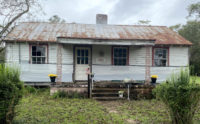"We must give up the idea that we are English country squires and plan our houses compactly. Our countryside is being used up by these millions of little boxes. We should be inspired by the Mediterranean countries which have, as you know, compact villages, towns with houses built wall to wall and privacy obtained by cloistered walled gardens, courtyards and atriums. And in planning compactly this way we will save the open countryside. . . .
"Another current fad in these individual dwellings, which I decry, is the so-called ranch house. This rage for informality in American life, I believe, is a lame excuse for laziness. It's obviously easier to feed the children hamburgers in the back yard in the manner of ranch hands from a chuck wagon than it is to have them sit at a table where they might conceivably acquire some dignity, manners and grace."
In describing this atrium house he said, "When I did houses in the past, I used to have the living and dining and kitchen areas related to each other with the bedrooms in a wing along a gallery or a long hallway.
"In recent years certain distaff publications have 'sold' the idea that the front door should provide access to the bedroom, kitchen and living room and this has inevitably meant some sort of pat plan. It has negated our wistfulness over the open plan.
"The idea of a great open space through the house is an appealing one to me. A more spacious plan does away with all hallways, the bane of my existence.
"If you will notice the Paterno plan . . . you enter a nice atrium with the living room on one side. This house is done on a 15-sq-ft module-each square terminating in a top-lighted well with a hanging garden. All windows are floor to ceiling, and sliding.
The jambs have sliding shoji screens-either translucent or opaque; thus there is no need for curtains. The kitchen side of the house opens into a garden room-an all weather outdoor area. That, in turn, is connected with a billiard room, servant's room and garage. There is a paved granite forecourt. The house is not a major piece of construction-just an orderly simple framing arrangement.
"An architect should be a humanitarian before he is an architect. He must not put his client in an arbitrary strait jacket. A home generally represents a man's life savings. The architect should single out those requirements of the client which are unique to him and must be met in a building. If the requirements and prejudices of each individual client are met, the architect should end up with a new solution rather than a preconceived idea.
"The exterior of the Paterno house is gray wood shingle with white trim and white trellises--a bow to tradition, and compatible with the nearby countryside as are the fieldstone retaining walls. Floors are of white marble, in deference to Mr. Paterno and the Italian tradition."




